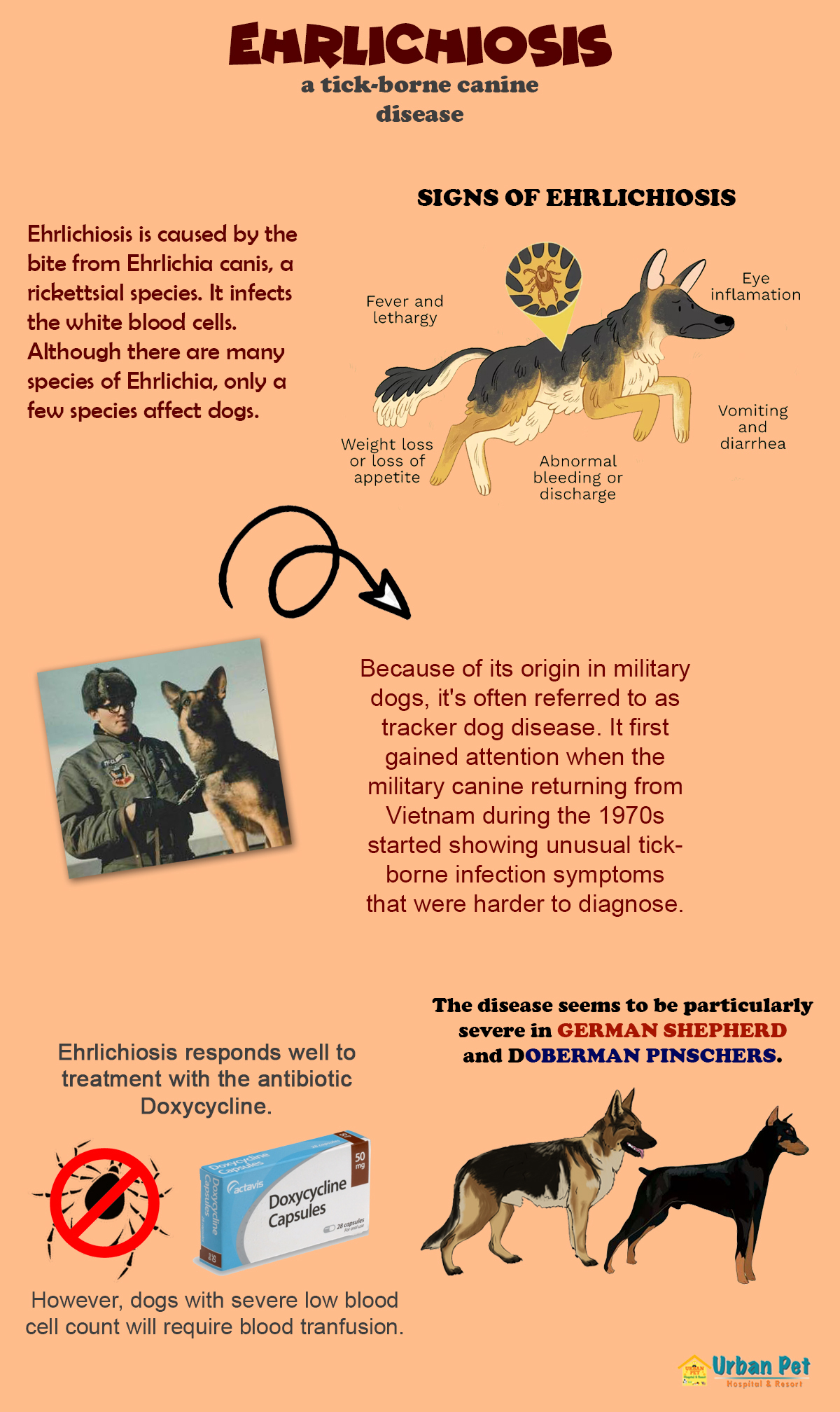Ehrlichiosis is unlike any other canine disease. If you find pronouncing 'Ehrlichiosis' difficult, you can call it 'Canine Typhus.'
Also known as a canine rickettsiosis, canine hemorrhagic fever, or tracker dog disease, Ehrlichiosis is a tick-borne disease common in dogs. While in some cases, it also infects humans and other animals. The news of Ehrlichiosis in dogs comes out every year, but not many dog owners are aware of the disease, its symptoms, and possible treatment.
Here is everything you need to know about this canine disease.
What is Ehrlichiosis?
Ehrlichiosis is caused by the bite from Ehrlichia canis, a rickettsial species. It infects the white blood cells. Although there are many species of Ehrlichia, only a few species affect dogs.
Because of its origin in military dogs, it's often referred to as tracker dog disease. Many experts often refer to it is as tropical canine pancytopenia. It is also possible for dogs to become infected through a blood transfusion from an infected dog. Although.
This tick-borne disease also infects humans and other species, including cats. However, dogs do not transmit the bacteria to humans or other animals; instead, ticks transmit to the Ehrlichia organism. Clinical signs of human ehrlichiosis include fever, headache, eye pain, and gastrointestinal upset.
What makes it different from other tick-borne diseases?
Ehrlichiosis is caused by the bite from an infected tick or brown dog tick carrying the bacterium Ehrlichia Canis. It first gained attention when the military canine returning from Vietnam during the 1970s started showing unusual symptoms that made it hard to diagnose.
Ehrlichia Canis was first defined in 1935 and found in the US in 1963. Today, the pathogen is found throughout the US, South America, Asia, Africa, and Australia.
The disease seems to be particularly severe in German Shepherd Dogs and Doberman Pinschers.
Stages of Ehrlichiosis
Dogs mostly appear perfectly normal for one to three weeks after being infected by E.canis. If your dog fails to fight off the infection during this time, it will enter an acute phase of infection when the bacteria start reproducing and spreading throughout the body.
The symptoms last for two to four weeks, after which many dogs appear to get better on their own called a subclinical phase which can last for months to years.
Some dogs never progress out of the subclinical phase, but others eventually enter the chronic phase of the disease.
Ehrlichiosis is divided into three stages
- Acute (early disease)
- Sub-clinical (no outward signs of disease)
- Clinical or chronic (Long-standing infection)
Acute Phase
The acute phase is defined by telltale symptoms including;
- Fever
- Swollen lymph nodes
- Respiratory distress
- Weight loss
- Bleeding disorders (Hemorrhage or bleeding)
- Neurological disturbances (Meningitis)
The stage lasts for two to four weeks. If your dog is lucky, they might fight off the infection; otherwise, they'll head into the sub-clinical phase.
Sub-clinical phase
This phase represents the stage of infection with the presence of organism but zero symptoms. It's often called the worst phase because there are no clinical signs, so the disease goes undetected. The only way to address the infection is through a blood test.
Clinical Ehrlichiosis
It only occurs when the dog's immune system fails to eliminate the organism. There are telltale signs of clinical ehrlichiosis, including;
- Anemia
- Fever
- Poor appetite
- Bleeding episodes
- Lameness
- Eye problems
- Neurological problems
- Swollen limbs
The failure of bone marrow prevents the manufacture of new blood cells.
Diagnosing Ehrlichiosis in dogs
The diagnosis is often complicated because dogs infected with Ehrlichia may also be infected with other diseases carried by ticks, such as Babesia, Lyme disease, or Rocky Mountain spotted fever.
You can only diagnose ehrlichiosis when your dog starts showing symptoms, so you need to be awry about the early signs, including fever, lethargy, poor appetite, and lymph node enlargement.
Whichever form of ehrlichiosis a dog has, it is essential that he be evaluated by a veterinarian as quickly as possible.
As part of the diagnostic process, the vets will collect a complete health history, perform a thorough physical exam, and then run a complete blood count (CBC), blood chemistry panel, urinalysis, fecal examination, and specific lab work aimed at diagnosing ehrlichiosis.
Also called serologic testing, the vet will check for the presence of antibodies against the Ehrlichia organism.
Your dog should test positive for exposure to be diagnosed with ehrlichiosis, which is only possible at the sub-clinical phase.
Prognosis
The prognosis is suitable for dogs with acute ehrlichiosis. Your vet will predict possible symptoms in the future and advise regular tests to assess the development of infection.
Treatment
Ehrlichiosis responds well to treatment with the antibiotic Doxycycline. However, a long course of treatment, usually four weeks, is needed. Alternatively, imidocarb can also be used.
If caught before the clinical stage, E. Canis is almost entirely curable.
In severe cases where blood cell counts are very low, blood transfusions may be needed. A dog experiencing anemia or bleeding will require a blood transfusion.
Reinfection is possible, as immunity to Ehrlichia bacteria is not long-lasting. The prolonged presence of the bacteria leads to hemorrhaging, which typically results in death.
Preventing Ehrlichiosis in Dogs
Ehrlichiosis is a recurring disease, and dogs who have been infected once can develop it again. However, there aren't any vaccines currently available to protect dogs against ehrlichiosis.
For now, the best way to prevent your dog from getting ehrlichiosis is to protect them from tick bites.
For More information please check this infographic.

Talk to your veterinarian in Urbandale to use the best form of tick prevention based on your dog’s health, lifestyle, and the prevalence of ticks and ehrlichiosis in your area. Tick bites are expected during the spring and summer seasons. Use this spring dog care checklist to ensure your furry friend remains flea and tick-free at all times.